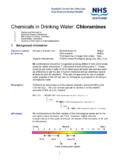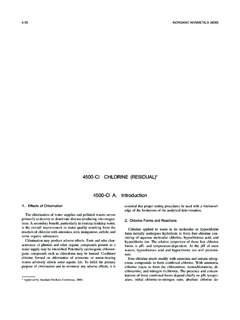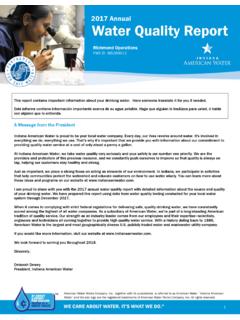Transcription of Basic Chemistry of Chlorination
1 Basic Chemistry of ChlorinationChlorine (Cl2) is a gas, heavier than air, toxic, non-flammable and an economically available oxidizing agent that provides properties desirable in disinfection is available in one of three forms: sodium hypochlorite, calcium hypochlorite and liquid chlorine. 1. Sodium hypochlorite, commonly called liquid bleach , is commercially available in strengths approximately 15% by weight. It can be added to the receiving stream by gravity, by the use of a chemical metering pump, or by physically dumping it.
2 2. Calcium hypochlorite, generally referred to as powder chlorine . It contains 70% available chlorine. It can be added to the receiving stream by use of pellets or by mixing a solution of water and calcium hypochlorite, decanting the solution into a tank and using a small chemical feed pump. 3. Liquid chlorine, known also as chlorine gas , is chlorine in its elemental form. It is available as a compressed gas of 100% strength. The most common ways of adding elemental chlorine to a receiving stream are to feed gas with a vacuum-operated solution feed system, or to feed the gas under comparing elemental chlorine as an oxidizing agent to powder (calcium hypochlorite) or solution (sodium hypochlorite), the oxidizing effect is the same.
3 That is, all three produce hypochlorous acid, the oxidizing agent present for disinfection in water and waste water chlorine gas is dissolved in water, it also reacts with the water to form hypochlorous acid and hydrochloric acid:Cl2 + H2O = HOCl + HClWhen a hypochlorite is added to water, it also reacts to form hypochlorite ion and hydroxide:NaOCl + H2O = OCl + OH These forms can exist together and the relative concentration of each depends on the pH of the solution and not on whether chlorine gas or bleach was added:HOCl OCl + H+The slight contribution of alkali when a hypochlorite is added or the slight contribution of acid when chlorine is added, generally, makes no difference in the final pH of the water.
4 The amount of chlorine added in either form is very small compared to the buffering power of most waters. INSTRUMENTS 600 Emlen Way, Telford, PA 18969 Telephone: (215) 799-0980 Fax: (215) 799-0984 BCOC Rev. 7/10 Toll Free in the : 1 (888) 38-HYDRO IN USA2 Basic Chemistry of ChlorinationThe pH of the water is important relative to the varying proportions of the hypochlorous acid and hypochlorite ions. In a solution with pH rising over the proportion of hypochlorous acid declines from virtually 100% down to almost 0 at pH The activity of hypochlorous acid as a bactericide is greatly superior to that of the hypochlorite, being almost 80 times more powerful.
5 It may be concluded that in free residual Chlorination , the higher the pH value the less active is the residual because of its lower proportion of hypochlorous acid. The graph below shows how the equilibrium changes with pH. (Fig. 1)Fig. 1: Relationship Between HOCl and OCl at Various pH ValuesThe Chemistry of chlorine in water stated before is true for pure water, and much more occurs in natural waters and in wastes. All wastewater contains ammonia (NH3) and some potable waters do too. Often when potable waters are chlorinated, ammonia is deliberately added to maintain a residual for a longer possible reactions between HOCl and ammonia are as follows:NH3 + HOCl H2O + NH2Cl (Monochloramine)NH3 + 2 HOCl 2H2O + NHCl2 (Dichloramine)NH3 + 3 HOCl 3H2O + NCl3 (Nitrogen Trichloride)These reactions occur essentially instantaneously and are pH dependant.
6 At pH levels above only mono-chloramine is formed; below this, mixtures of mono and dichloramine result; and below pH only nitrogen trichloride exists. For wastewater and drinking water that has been treated with both ammonia and chlorine, the predominant species is monochloramine. The chloramines, together with some other compounds that can occur are totaled and considered combined available chlorine. These forms of chlorine, although much weaker than hypochlorous acid, are very useful in some sufficiently high chlorine dosages are applied to waters containing ammonia different reactions will occur resulting in the destruction of the ammonia and the formation of free chlorine residual.
7 Figure 2 shows what typically occurs with increasing chlorine dosages for water containing Chemistry of Chlorination 3 Low chlorine dosages result in the formation of mono and dichloramine and are depicted as increasing residual on the left end of the curve (Fig. 2). The peak of the curve occurs when all of the free ammonia is used up forming chloramines. This usually occurs when the dosage reaches 8 or 10 times the ammonia concentration. This is called the breakpoint. After breakpoint the combined chloramines are present as free chlorine which is a mixture at normal pH values of hypochlorous acid and 2: Breakpoint CurveRecognition of these two forms of residual chlorine is of the greatest importance since the chemical, bactericidal and virucidal properties of free chlorine are vastly superior to those of combined chlorine.
8 For maximum safety in the production of germ-free water, it is essential to chlorinate to the point of establishing free chlorine. That the treatment has been properly carried out can only be established by using test procedures capable of measuring free chlorine separate from combined this simplified Chemistry of Chlorination , we might look to some of the definitions of terms used in Chlorination of TermsMany factors determine the exact amount of chlorine to be fed in a given application to obtain the desired results.
9 Gas Chlorinators operate over a wide range of flow rates and usually can be converted to higher or lower rates very easily. The maximum flow rate of a gas chlorinator is at least twenty (20) times its minimum rate, with any capacity metering tube. As an aid to readers who may be unfamiliar with some of the Basic terms used in Chlorination and in water and wastes treatment, the following definitions might be helpful:Dosage: The amount of chlorine put into water or sewage expressed in parts per million (PPM) or milligrams per liter (mg/L).
10 Demand: The amount of chlorine required to react with the organic and inorganic substances and to kill the bacteria contained in the water : The liquid discharge of a treatment plant or of a piece of equipment or tank within the : Biochemical Oxygen Demand, referring to the required amount of oxygen necessary for the chemical and biological oxidation of waterborne substances in a specific time, under specific Basic Chemistry of ChlorinationPPD: Pounds Per Day, referring to pounds of chlorine per day required to do a specific job (expressed in the metric system as Grams Per Hour = gr/hr, referring to the grams of chlorine per hour required to do a specific job).









